In a world where new e-commerce platforms seem to pop up every year, eBay dropshipping might feel like an "old-school" business model — but the numbers tell a different story. In 2025, eBay continues to draw over 135 million active buyers and facilitates billions of dollars in transactions each quarter, making it one of the most consistent and globally recognized marketplaces for online sellers.
The appeal lies in its built-in audience, search-driven buying behavior, and category diversity — from niche collectibles to trending lifestyle products. Unlike platforms that rely heavily on algorithmic feed discovery, eBay customers often arrive with a clear purchase intent, which gives dropshippers a better chance at converting views into sales.
For entrepreneurs, this means a lower barrier to entry, fewer marketing costs upfront, and a chance to ride emerging product trends without the risk of bulk inventory. The key in 2025 isn't just listing products — it's knowing which products to list, where to source them, and how to fulfill orders quickly enough to match customer expectations.
What is eBay Dropshipping?
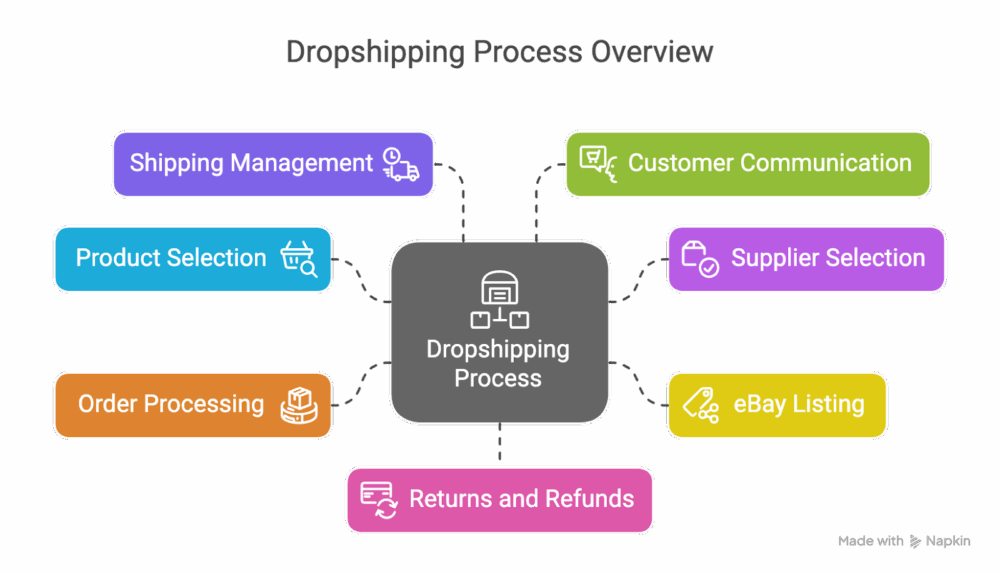
eBay dropshipping is a business model that allows sellers to list products for sale on eBay without holding physical inventory. Instead of stocking items, sellers partner with third-party suppliers who store, package, and ship the products directly to customers once an order is placed. This model lowers the barrier to entry for entrepreneurs who want to start selling online without investing large sums in upfront inventory.
What makes eBay dropshipping unique is its reach. eBay has over 130 million active buyers worldwide, making it one of the largest marketplaces to tap into. For beginners, it provides instant access to a global audience without the need to build a website or manage complex logistics. Essentially, sellers focus on product research, listing optimization, and customer service, while suppliers handle the backend fulfillment.
However, dropshipping on eBay isn’t as simple as listing items from any supplier. eBay has clear rules about which fulfillment models are allowed. Sellers must ensure they are sourcing from wholesale suppliers rather than other retailers, and the products must reach customers within the promised timeframe. Those who succeed often specialize in niche categories—such as home goods, electronics accessories, or seasonal items—and use data-driven research tools to find products with proven demand.
For new entrepreneurs, the model offers a way to test multiple niches with minimal financial risk. It can be a learning ground for understanding customer behavior, managing listings, and building an online selling system. When executed correctly, eBay dropshipping can serve as a springboard for expanding into private label products, branded stores, or even multi-channel eCommerce strategies.
eBay Dropshipping Policy
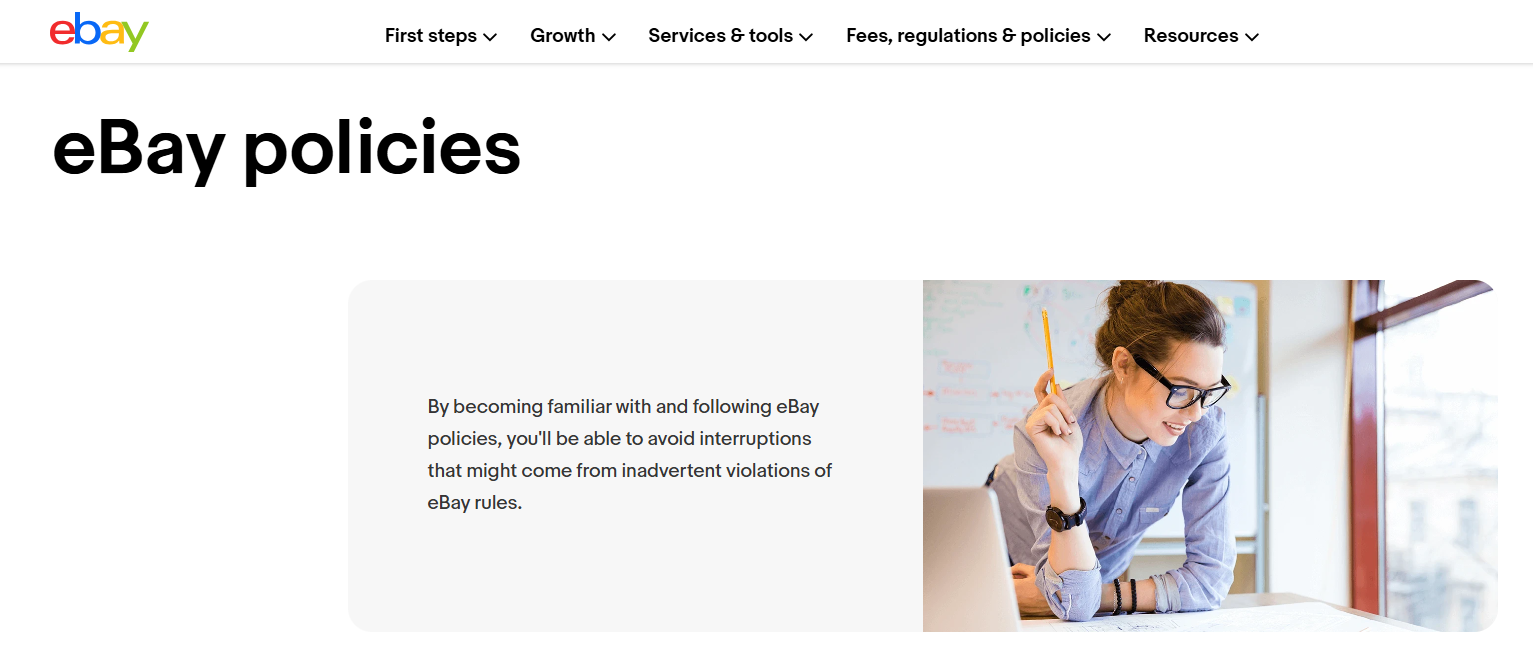
Understanding eBay’s dropshipping policy is essential for staying compliant. In simple terms, eBay allows dropshipping but only under specific conditions. Sellers are permitted to use suppliers that act as wholesalers or manufacturers who can fulfill orders directly to the customer. What is not allowed is “retail arbitrage”—where sellers buy products from another retailer or marketplace (like Amazon or Walmart) and then ship them to eBay buyers.
Violating these policies can lead to serious consequences, including listing removals, lower search visibility, or even account suspension. eBay’s main concern is ensuring buyers have a consistent and reliable shopping experience. Therefore, sellers are responsible for order accuracy, on-time delivery, and handling any returns.
1. What eBay Allows
-
Sellers may use wholesale suppliers, manufacturers, or distributors to fulfill orders directly to customers.
-
The supplier must be able to ship the product quickly and provide valid tracking information that can be uploaded to eBay.
-
Sellers remain fully responsible for the buyer’s experience—including order accuracy, on-time delivery, and handling returns or disputes.
2. What eBay Prohibits
-
Retail Arbitrage (Not Allowed): Purchasing items from another retailer or marketplace (e.g., Amazon, Walmart, AliExpress) after a customer has placed an eBay order is considered a violation.
-
Branded Packaging/Invoices from Third Parties: Orders cannot be shipped with invoices, packaging, or paperwork that show another retailer’s name or logo.
-
Late or Missing Tracking Numbers: Failing to provide buyers with valid tracking within eBay’s deadlines violates the policy.
-
Unreliable Supply Chains: Repeated stock-outs, slow shipping, or mismanaged suppliers can trigger policy violations.
3. Seller Responsibilities Under the Policy
-
Timely Delivery: Sellers must meet the estimated delivery date promised on the listing.
-
Accurate Listings: Descriptions, specifications, and item condition must match what the buyer receives.
-
Returns & Refunds: Sellers—not suppliers—are responsible for handling returns according to eBay’s Money Back Guarantee.
-
Customer Communication: Prompt responses to buyer inquiries and resolution of disputes are required to maintain account health.
4. Performance Standards
eBay uses seller metrics to measure compliance. Dropshippers must maintain:
-
On-time shipping rate
-
Valid tracking upload rate
-
Low defect rate (few order cancellations, missing items, or misrepresentations)
-
Positive feedback from buyers
Poor performance may result in search demotion, listing removal, selling restrictions, or account suspension.
5. Best Practices for Compliance
-
Work with established dropshipping suppliers (wholesalers, distributors, fulfillment centers).
-
Test suppliers before scaling to ensure reliability.
-
Keep extra buffer time in delivery estimates to avoid late shipments.
-
Use eBay’s business policies feature to set clear shipping, return, and payment terms.
-
Monitor account health in Seller Hub > Performance Tab to spot issues early.
For beginners, compliance means carefully vetting suppliers before listing products. Reliable partners will not only meet eBay’s expectations but also help maintain seller metrics such as shipping speed, defect rates, and customer feedback scores. Maintaining healthy account performance is vital, as eBay uses these metrics to rank listings in search results. Sellers who consistently perform well may be rewarded with higher visibility, boosting sales potential.
How eBay Dropshipping Operates in Today's Market
eBay dropshipping in 2025 isn't the "list anything, sell fast" model it used to be. The marketplace has matured, buyers are more informed, and eBay's algorithm rewards quality, consistency, and speed over volume. Sellers who thrive now treat their stores like true e-commerce brands rather than opportunistic resellers. Here's a closer look at how it operates today:
1. Product Listing & Optimization
The process starts with listing products sourced from reliable suppliers. Success hinges on high-quality titles, clear descriptions, accurate specs, and professional images. Keywords matter—titles should include common buyer search terms without stuffing. Good listing optimization not only improves search visibility on eBay but also builds buyer trust before they even click "Buy."
2. Reliable Sourcing & Inventory Management
Real-time inventory tracking is now a non-negotiable. Out-of-stock cancellations instantly hurt seller performance metrics and can lead to account restrictions. Top dropshippers partner with suppliers that integrate directly with eBay's backend to automatically sync stock levels and pricing, preventing overselling.
3. Shipping Standards & Speed
Fast, trackable shipping is one of the biggest factors in winning the Buy Box. While overseas suppliers are still used for niche or unique items, US or EU-based warehouses are increasingly preferred to meet eBay's delivery expectations of 5–12 business days. Long delivery times can push listings down in search results, regardless of product demand.
4. Customer Service & Feedback Ratings
eBay's feedback system still carries weight. Prompt responses to inquiries, proactive issue resolution, and clear return policies all contribute to positive ratings. Many successful dropshippers view customer service not just as problem-solving, but as a sales conversion tool—happy buyers are far more likely to become repeat customers.
5. Pricing Strategy & Competitiveness
Pricing on eBay is a balancing act: competitive enough to win clicks, profitable enough to sustain growth. Savvy sellers analyze competitors' pricing daily, use volume discounts, or offer bundles to increase perceived value without eroding margins.
6. Platform Compliance & Risk Management
eBay's policies now explicitly prohibit dropshipping from other marketplaces like Amazon or Walmart. Sellers must work with wholesale-level or manufacturing suppliers who can directly fulfill orders to remain compliant. Violations can lead to immediate listing removals or permanent suspensions.
7. Data-Driven Decision Making
Modern eBay dropshipping is data-heavy. Sellers track sell-through rates, competitor listings, keyword search trends, and seasonality to decide what to scale and what to drop. This analytical approach replaces the "throw everything online" mentality of the past.
Key Qualities of a Winning eBay Dropshipping Product
Not every product is built for long-term success on eBay. The items that truly stand out share certain qualities that align with buyer expectations, eBay's search algorithm, and a dropshipper's operational strengths. Here's what to look for when choosing a winning product in 2025:
1. Steady, Proven Demand
A good eBay product isn't just a passing trend—it's something that maintains consistent sales month after month. This could be a staple household item, a seasonal favorite with predictable peaks, or a niche product that solves a specific problem. Checking completed listings, sell-through rates, and watch counts can help confirm whether the demand is real.
2. Low Return Risk
High return rates can kill your profit margin and hurt your seller rating. Products with simple sizing, fewer moving parts, and minimal customization tend to have fewer returns. Avoid categories notorious for sizing issues (like shoes) unless you have detailed charts and supplier quality assurance in place.
3. Strong Margin Potential
Even the highest-selling product isn't worth it if your profit margin is razor-thin. Winning eBay products often have at least a 25%–40% markup after fees and shipping costs. Look for items that aren't flooded with identical competitors, where branding or bundling can help justify a higher price.
4. Lightweight & Easy to Ship
Shipping costs play a huge role in final pricing competitiveness. Products that are under 2 lbs (0.9 kg) and compact enough for standard packaging give you more flexibility in offering free or low-cost shipping—both of which can boost your conversion rate.
5. Unique Appeal or Differentiation
eBay buyers scroll through dozens of similar listings. A winning product stands out—maybe it's an upgraded version of a common item, a trending color, a bundled set, or something not widely available from local retailers. This uniqueness helps reduce price wars and keeps your listing competitive.
6. Compatible with eBay's Search Algorithm
Products with clear titles, searchable keywords, and high-quality images naturally rank better in eBay search results. Certain categories (like electronics accessories, home improvement, and collectible items) also tend to get higher visibility when paired with competitive pricing and fast shipping.
Top eBay Dropshipping Products to Watch in 2025
1. Smart Home Devices
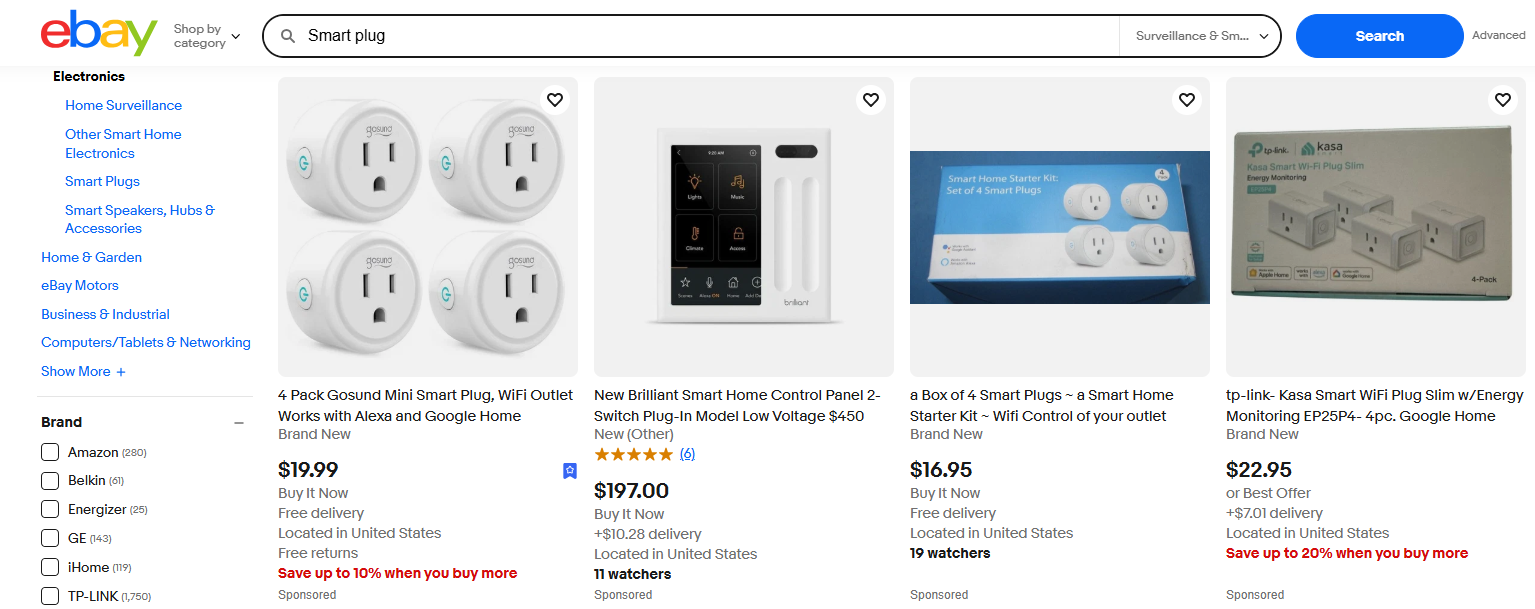
Why They Work: Smart plugs, bulbs, and mini security cameras have consistent search demand, fueled by the growing adoption of Alexa and Google Home. Their relatively compact size means cheaper, faster shipping — a plus for competitive pricing.
Sourcing Tip: Look for suppliers offering OEM or white-label options to differentiate your listings and bundle accessories like smart remote controls.
2. Home Office Accessories
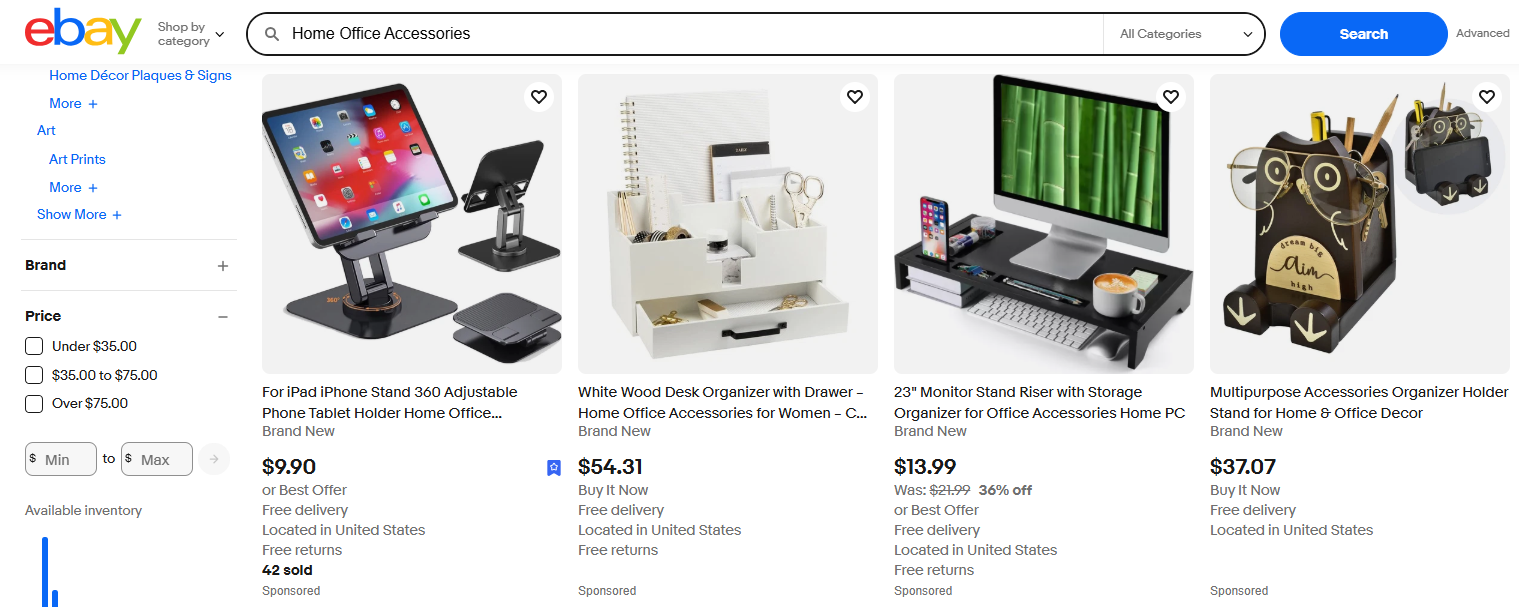
Why They Work: Products like ergonomic chairs and laptop stands are still trending because hybrid work hasn't faded. Lightweight, flat-pack items can reduce shipping costs while maintaining good margins.
Sourcing Tip: Partner with suppliers that offer multi-size or adjustable options, so you can cater to various workspace setups without increasing SKU complexity.
3. Portable Power Banks

Why They Work: High search volume year-round, especially for multi-port or wireless models. They're small, lightweight, and often impulse buys under $30.
Sourcing Tip: Source from suppliers who can provide clear mAh capacity certifications and fast-charging compatibility — it boosts buyer trust and reduces returns.
4. Kitchen Gadgets
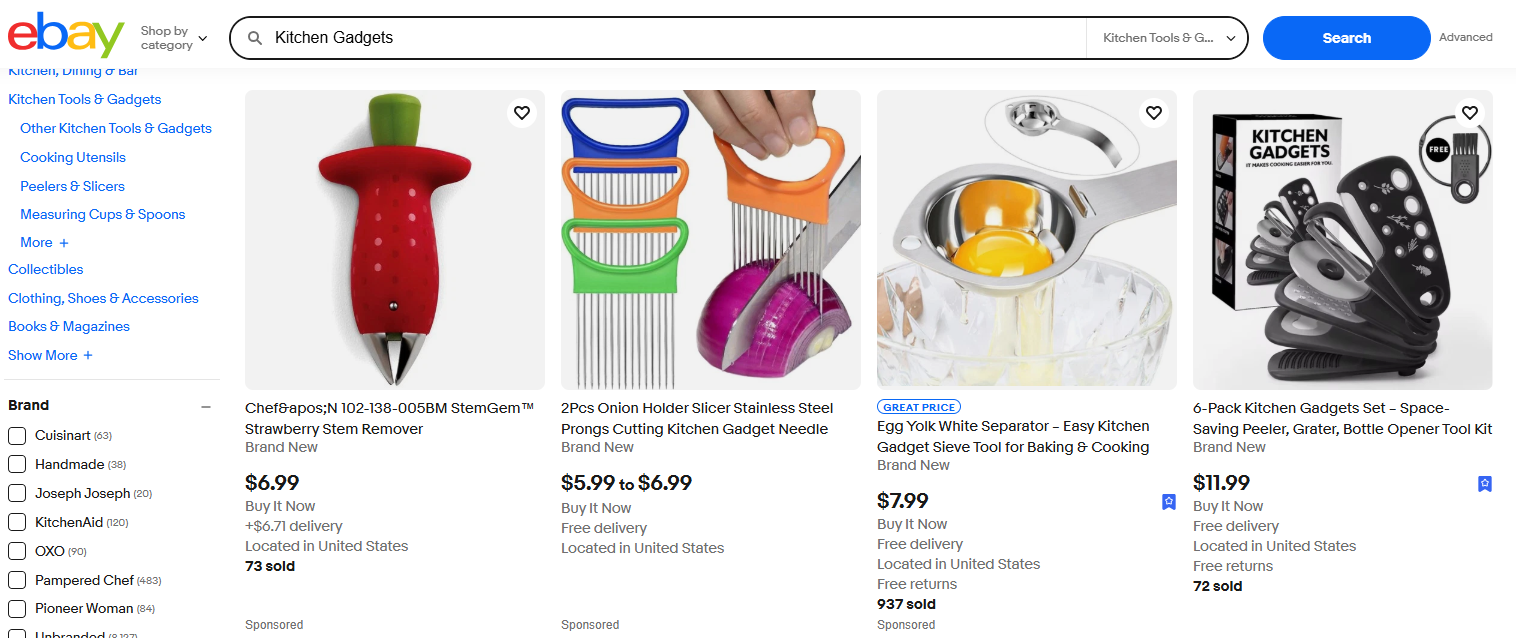
Why They Work: Affordable, problem-solving tools like vegetable spiralizers or silicone mats are always in demand. Low breakage risk and compact packaging help maintain profit margins.
Sourcing Tip: Choose suppliers who can provide short demo videos you can repurpose in listings — eBay's algorithm favors engaging multimedia.
5. Eco-Friendly Reusables
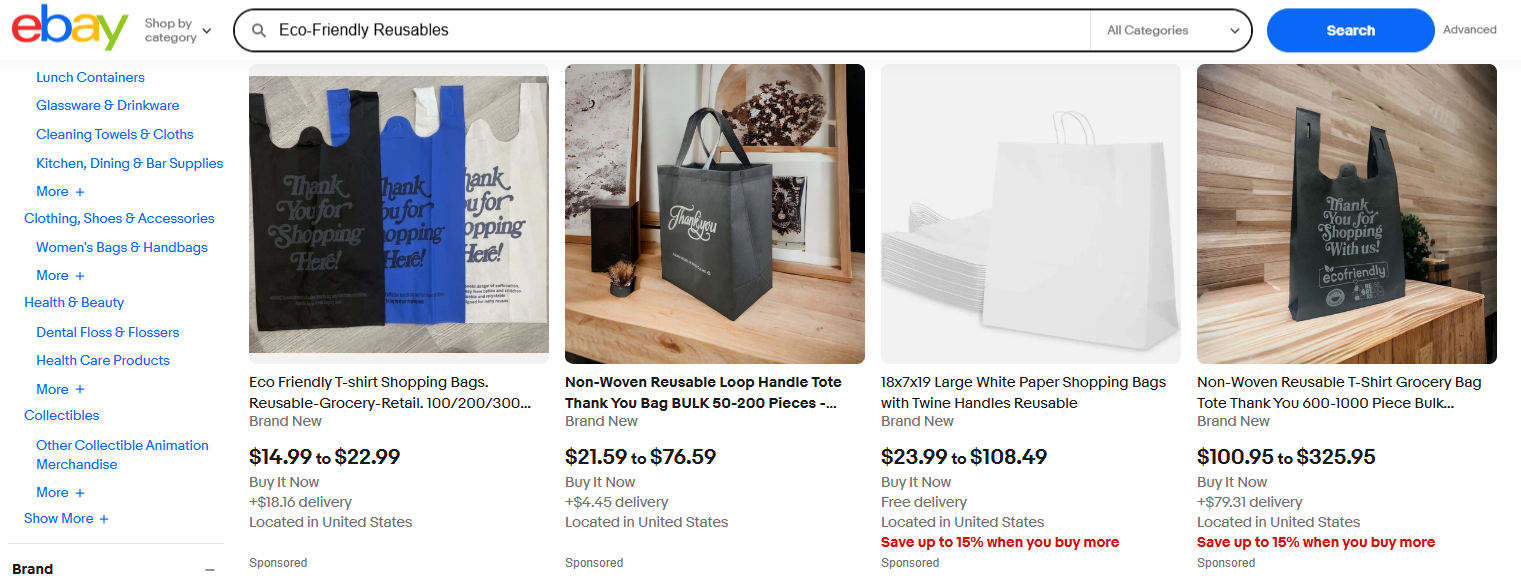
Why They Work: Bamboo cutlery sets and reusable produce bags appeal to sustainability-conscious shoppers. Small and lightweight for cheap global delivery.
Sourcing Tip: Work with suppliers offering recycled or certified organic materials — adding this in your listing can justify higher prices.
6. DIY & Craft Supplies
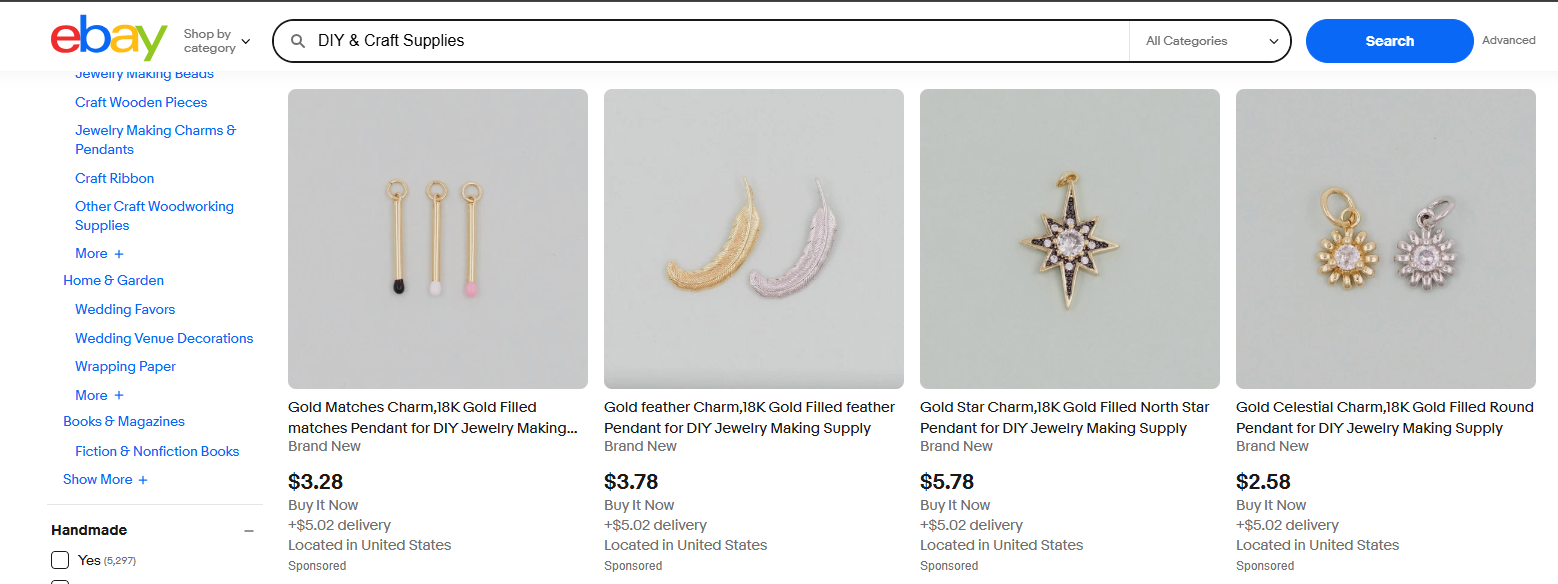
Why They Work: Vinyl sheets, silicone molds, and heat press tools attract loyal hobbyists. Products are usually low-cost to ship and have steady repeat-purchase potential.
Sourcing Tip: Source seasonal designs or limited-edition color sets to tap into spikes during holidays and craft fairs.
7. Pet Grooming Tools
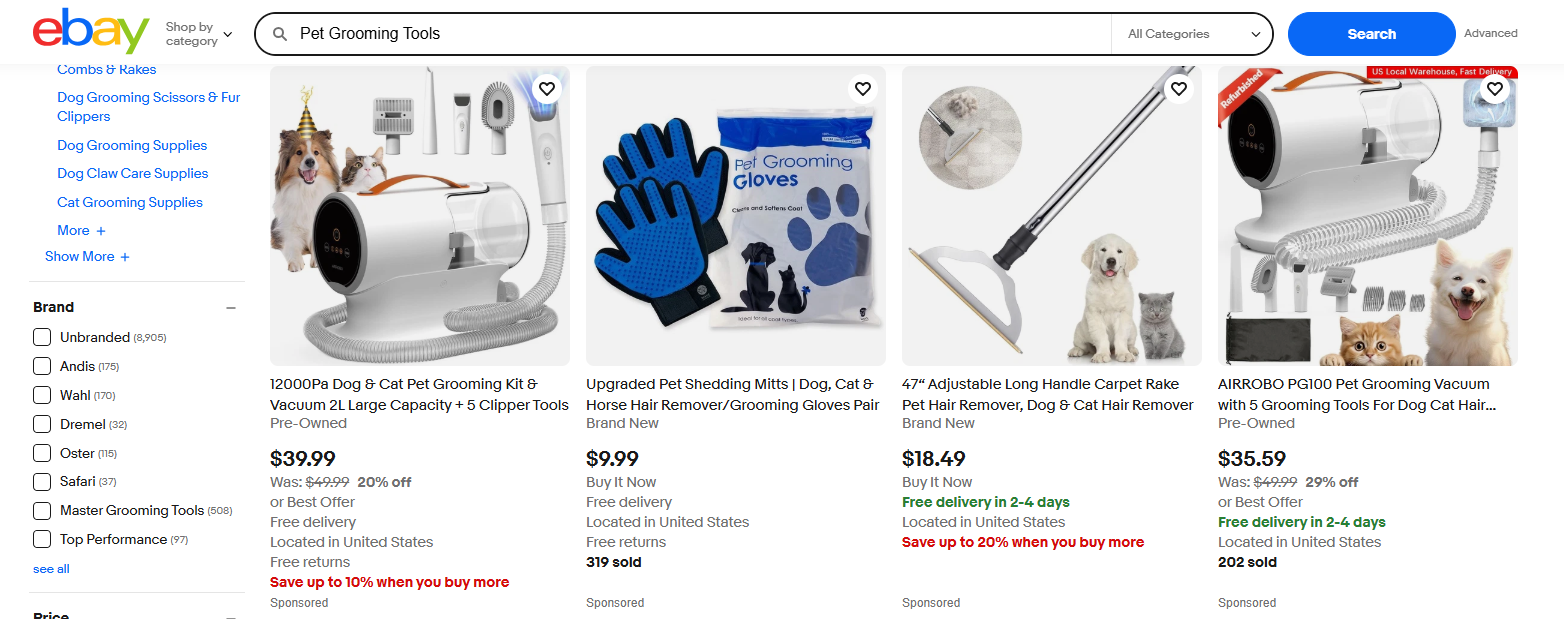
Why They Work: De-shedding brushes and paw washers have high, stable search volume. They're lightweight, easy to ship, and not prone to breakage.
Sourcing Tip: Choose suppliers who can package products in branded resealable bags — it increases perceived value.
8. Fitness Accessories
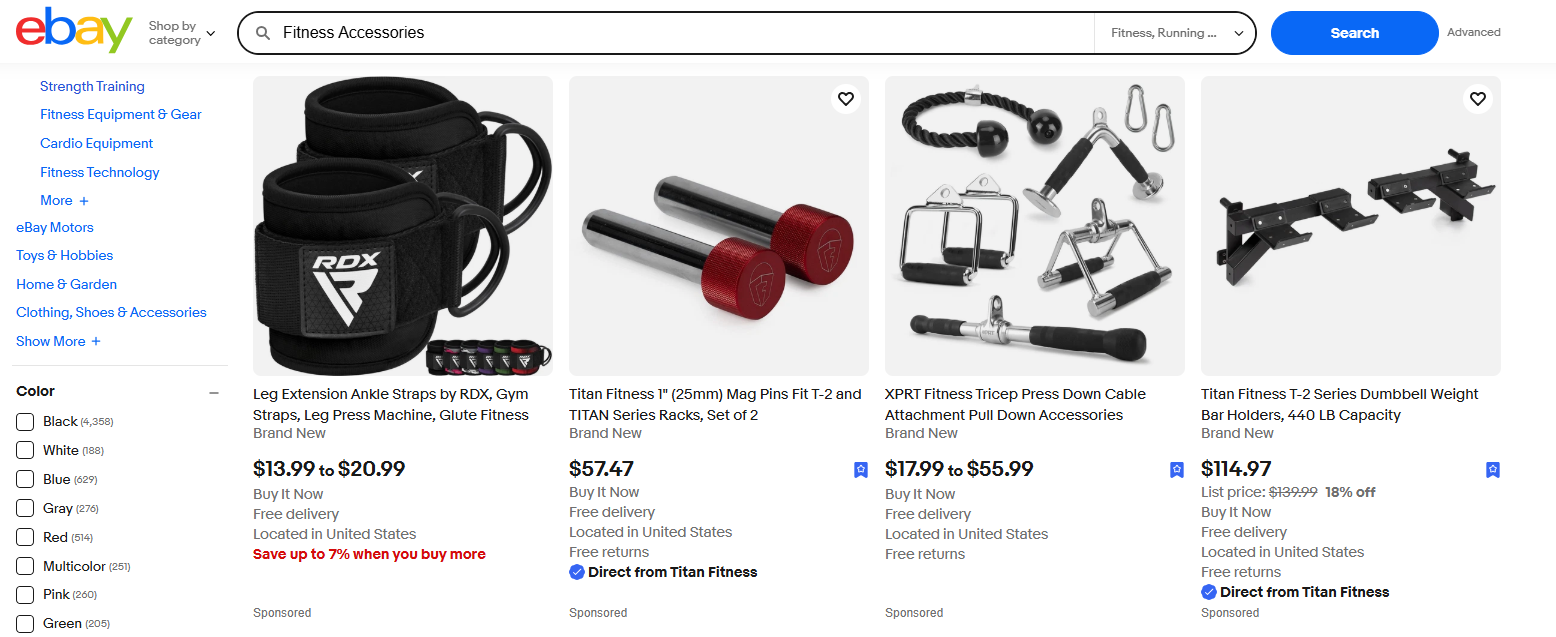
Why They Work: Resistance bands and yoga wheels are compact, high-margin, and trending thanks to at-home fitness enthusiasts.
Sourcing Tip: Look for suppliers offering bundles (e.g., resistance bands + workout guide) to upsell without adding weight.
9. Car Organizers & Accessories
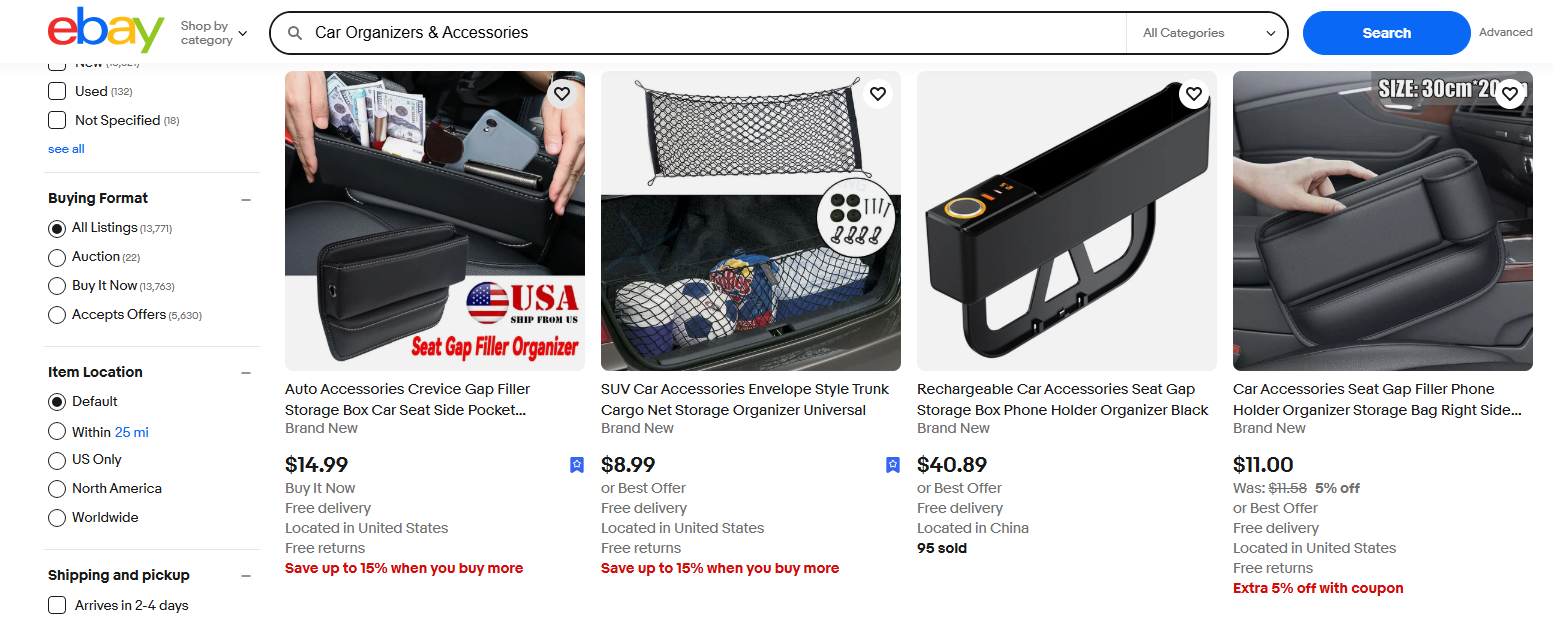
Why They Work: Low-cost, high-utility products like trunk organizers see steady demand. They're lightweight and inexpensive to ship domestically and internationally.
Sourcing Tip: Partner with suppliers who provide universal-fit designs — fewer returns due to sizing issues.
10. Niche Collectibles

Why They Work: Retro gaming cartridges and enamel pins have passionate audiences and high repeat purchase rates. They're small enough for inexpensive tracked shipping.
Sourcing Tip: Source from verified or licensed suppliers to maintain authenticity — critical for avoiding negative feedback.
Step-by-Step eBay Dropshipping Setup for Beginners
1.Create and Set Up Your eBay Seller Account

-
Register for an eBay Business Account instead of a personal account to access advanced seller features.
-
Complete your business profile, including business name, tax information, and bank details.
-
Set up Payoneer (eBay’s default payout system) for receiving payments.
2. Research and Select Your Niche

-
Focus on categories that fit dropshipping well (e.g., home goods, electronics accessories, coffee, pet products).
-
Use Terapeak Product Research (free inside eBay Seller Hub) to analyze trending items and competition.
-
Avoid highly restricted or brand-sensitive categories (luxury goods, branded electronics).
3. Find Reliable Dropshipping Suppliers
-
Work only with wholesalers, manufacturers, or fulfillment providers (not retail stores).
-
Examples: CJdropshipping, SaleHoo, Syncee, or private distributors.
-
Test supplier performance—check shipping times, packaging quality, and stock stability before scaling.
4. List Products on eBay
-
Use Seller Hub > Listings to create professional product listings.
-
Include high-quality product images, keyword-rich titles, and accurate descriptions.
-
Set realistic handling times (e.g., 2–3 days) to avoid late delivery penalties.
-
Offer free shipping if possible—it boosts eBay search ranking.
5. Set Competitive Prices
-
Factor in eBay fees (~12–15%), Payoneer fees (~2%), supplier costs, and shipping expenses.
-
Use competitor analysis tools (e.g., ZIK Analytics) to benchmark pricing.
-
Keep margins realistic (aim for 15–25% gross margin) to sustain growth.
6. Manage Orders and Fulfillment
-
When a customer places an order, forward details to your supplier for direct shipment.
-
Always ensure tracking numbers are uploaded to eBay within the required timeframe.
-
Use tools like AutoDS or DSM Tool to automate order forwarding and tracking uploads.
7. Customer Service & Returns
-
Respond to customer inquiries within 24 hours.
-
Handle refunds or returns professionally—buyers expect sellers, not suppliers, to manage them.
-
Maintain compliance with eBay’s Money Back Guarantee policy.
8. Monitor Performance & Scale Up
-
Check your Seller Hub Performance Tab regularly to track defect rate, on-time shipping, and buyer feedback.
-
Gradually increase product listings and test new niches.
-
Once profitable, consider adding branding options (private label packaging or bundles) to differentiate your store.
✅ In summary: Beginners can set up eBay dropshipping successfully by choosing the right suppliers, creating optimized listings, and managing customer expectations. Long-term success depends on compliance with eBay’s dropshipping policy and strong supplier partnerships.
Pricing & Fee Calculations for Profitable eBay Dropshipping Margins
Profitability in eBay dropshipping hinges on understanding fees and setting prices that cover costs while remaining competitive. eBay charges an insertion fee for listing items (though you may get free monthly listings) and a final value fee based on a percentage of the total sale price, including shipping. Payment processing fees also apply, typically around 2.9% + $0.30 per transaction.
Here’s a breakdown of what you need to calculate:
-
Product Cost – The amount you pay to your supplier.
-
eBay Fees – Insertion and final value fees, which vary by category.
-
Payment Processing Fee – A small percentage plus a flat rate per transaction.
-
Shipping Costs – Depending on whether you or your supplier covers shipping.
-
Other Costs – Packaging, returns, or promotional listing fees.
A simple formula many sellers use is:
Selling Price – (Product Cost + eBay Fees + Payment Processing + Shipping) = Profit Margin
For example, if your supplier sells a product for $10, and you list it on eBay for $20:
-
Supplier cost: $10
-
eBay fees (10%): $2
-
Payment processing (3% + $0.30): $0.90
-
Shipping (covered by supplier): $0
Total cost: $12.90
Profit: $7.10
Margin: 35.5%
The goal is to aim for at least 20–30% profit margins to remain sustainable. Beginners often underestimate fees, which leads to slimmer profits than expected. It’s also wise to reinvest part of your profits into promoted listings, software tools, or branding improvements to stand out in competitive categories.
Finding Reliable Suppliers & Sourcing Strategies
In eBay dropshipping, your suppliers are the backbone of your business. A winning product is only profitable if it consistently arrives on time, matches its description, and delights the customer. In 2025's competitive landscape, sellers who treat supplier selection as a strategic process — not a quick checkbox — are the ones who win repeat customers and high seller ratings.
1. Start with Proven Supplier Credibility
Before committing to a supplier, check their transaction history, on-time delivery rate, and product feedback scores. A high positive rating isn't enough; you also want to look at how they resolve issues. Do they respond quickly to inquiries? Do they replace damaged items without long disputes? A supplier's after-sales behavior is often the best indicator of future reliability.
Pro tip: Order at least two sample units from different batches. This will reveal if the quality is consistent over time rather than just from a "showroom batch."
2. Match Fulfillment Speed to Customer Expectations
eBay buyers are increasingly accustomed to Amazon-like delivery times. If your listings offer faster delivery than your competitors, you'll win the click more often — even at a slightly higher price. Look for suppliers who can ship from domestic warehouses in your target market (e.g., US, UK, EU). This can cut delivery times from 20+ days down to as little as 3–7 days, which also reduces return disputes.
3. Negotiate Smart on MOQs and Pricing
One of the advantages of dropshipping is avoiding large upfront inventory costs. But negotiating small minimum order quantities (MOQs) while keeping your per-unit price competitive can significantly improve your margins. A solid supplier relationship can also unlock:
-
Priority restocking during high-demand periods.
-
Exclusive access to limited-run or trending products.
-
Tiered discounts based on your monthly sales volume.
4. Work with Multi-Category Sourcing Hubs
Instead of managing multiple suppliers across different niches, consider using a versatile platform like CJdropshipping, which is designed for scalability:
-
Custom Product Sourcing: You can request unique or hard-to-find products before they saturate the market.
-
Automatic Order Sync: Orders from your eBay store flow directly into the fulfillment system, reducing errors and manual work.
-
Global Warehouses: Stock in multiple regions for faster shipping and improved buyer trust.
-
Branding Options: Private labeling and custom packaging to make your eBay store stand out in a sea of similar listings.
By consolidating sourcing under one trusted partner, you also simplify communications and avoid the logistical chaos of juggling 10 different supplier relationships.
5. Identify Gaps Before They Become Trends
The best dropshippers don't just chase existing hot sellers — they spot them early. Use tools like eBay's Terapeak, Google Trends, and keyword research to find products with rising search volume but low competition. Then confirm your supplier can scale production and fulfillment before committing to marketing spend.
6. Build a Two-Tier Supplier Network
Even with a trusted main supplier, things can go wrong — factory delays, raw material shortages, policy changes. Maintain a secondary supplier for your bestsellers as a safety net. This "Plan B" approach ensures you don't lose momentum when demand peaks.
7. Sourcing Tip
When searching for new products on eBay, avoid suppliers offering an extremely wide variety of unrelated items — it can signal they are just middlemen. Instead, prioritize those specializing in a category, as they're more likely to have product knowledge, stable stock, and better quality control.
Fulfillment Tactics to Compete on Speed and Service
On eBay, fulfillment speed and service quality are the two pillars that directly influence search visibility, conversion rates, and seller feedback. With over 130 million active buyers and a marketplace where many sellers offer similar products, your fulfillment strategy can be the deciding factor in whether customers choose you over competitors — and whether they come back.
1. Use Regional Warehousing to Reduce Delivery Times
Fast delivery isn't just a "nice to have" — it's one of eBay's search ranking factors. If you want to qualify for the Fast & Free badge and improve your Best Match ranking, you need to store inventory closer to your customers.
-
US buyers: Aim for 2–5 day delivery by using suppliers or 3PL partners with warehouses in states like California, Texas, or New Jersey.
-
UK/EU buyers: Look for suppliers with fulfillment centers in the UK, Germany, or the Netherlands to cut customs delays.
-
Example: CJdropshipping offers fulfillment from US, UK, and EU warehouses, which can help sellers ship within days instead of weeks.
2. Automate the Order Flow to Eliminate Processing Delays
Every manual step between a customer clicking "Buy" and your supplier shipping the order is an opportunity for delay. Integrating your eBay store with a dropshipping platform ensures:
-
Orders are instantly pushed to the supplier.
-
Tracking numbers are auto-uploaded to eBay.
-
Customers receive shipment notifications without your intervention.
This not only speeds up order handling but also reduces the risk of miscommunication or overselling.
3. Offer Multiple Delivery Options to Match Buyer Priorities
Not all buyers want the cheapest shipping. Some prioritize speed for gifts or time-sensitive purchases, while others will wait longer to save money. Offering:
-
Standard Shipping (economical, 7–15 days)
-
Expedited Shipping (5–7 days)
-
Express Delivery (2–5 days)
These will give customers control and increase your average order value.
4. Invest in Packaging That Protects and Promotes
Delivery speed is meaningless if the product arrives damaged. Choose suppliers that use robust, moisture-resistant packaging and pay attention to the product fit inside the box. Consider branded or custom packaging for higher-value items — a service available via CJdropshipping — to make unboxing memorable and encourage repeat orders.
5. Have a Backup Plan for Peak Seasons
The fourth quarter, major sales events, and sudden viral spikes can strain supplier capacity. Protect your seller performance by:
-
Maintaining relationships with secondary suppliers for your best-sellers.
-
Keeping a small buffer of ready-to-ship stock in key warehouses.
-
Pre-booking fulfillment slots during Black Friday/Cyber Monday and holiday periods.
6. Monitor Carrier Performance and Adjust Quickly
Shipping times can fluctuate depending on carrier reliability, customs processes, or even weather. Track your on-time delivery metrics on eBay, and if you see delays from a specific shipping method, switch to a faster route before negative feedback piles up.
7. Communicate Proactively to Protect Feedback Scores
If a delay is inevitable, reach out before the buyer contacts you. A polite, proactive message explaining the situation — and possibly offering a small discount code for their next purchase — can turn a potentially negative review into a loyal repeat customer.
8. Sync Fulfillment With Listing Promises
Never promise faster shipping in your listings than you can consistently deliver. eBay tracks your handling and delivery accuracy; repeated missed ETAs can hurt your search ranking. Instead, set realistic delivery windows and exceed them whenever possible — a small over-delivery can make a big impression.
Tools & Resources to Scale Your eBay Dropshipping Business
Running a small eBay dropshipping operation can be manageable with spreadsheets and manual work — but if you want to scale, you need systems that automate repetitive tasks, give you real-time insights, and keep your operations smooth even as order volumes grow. The right combination of tools can save you hours every week, boost your profit margins, and help you compete with bigger sellers without adding unnecessary stress.
1. Product Research Tools: Spot Winners Before the Market Floods
Keeping your store stocked with high-demand items starts with reliable research.
-
Terapeak (inside eBay Seller Hub): Shows historical sales, pricing trends, and top-performing categories, helping you choose products with proven demand.
-
ZIK Analytics: Lets you spy on competitor strategies, monitor sell-through rates, and discover profitable niches with low competition.
-
Algopix: Offers cross-market analysis to see whether a product will perform well on eBay, Amazon, and Shopify, giving you more data before investing time in a listing.
Pro Tip: Combine Terapeak for historical data with ZIK Analytics for competitive insights — this mix gives you both a long-term and real-time view of product potential.
2. Listing Optimization Tools: Make Every Listing Count
Your listing is the digital "shop window" — and on eBay, the difference between page one and page five often comes down to keywords, images, and layout.
-
Title Builder: Creates keyword-rich titles that attract both eBay's search algorithm and human shoppers.
-
Canva / Fotor: Helps design professional product photos and infographics that make your listings stand out.
-
Inkfrog: Allows you to bulk edit listings, create reusable templates, and sync inventory across multiple platforms.
Pro Tip: Keep your titles under 80 characters for mobile-friendliness, but always front-load the main keywords buyers actually search for.
3. Automation & Order Management Platforms: Work Smarter, Not Harder
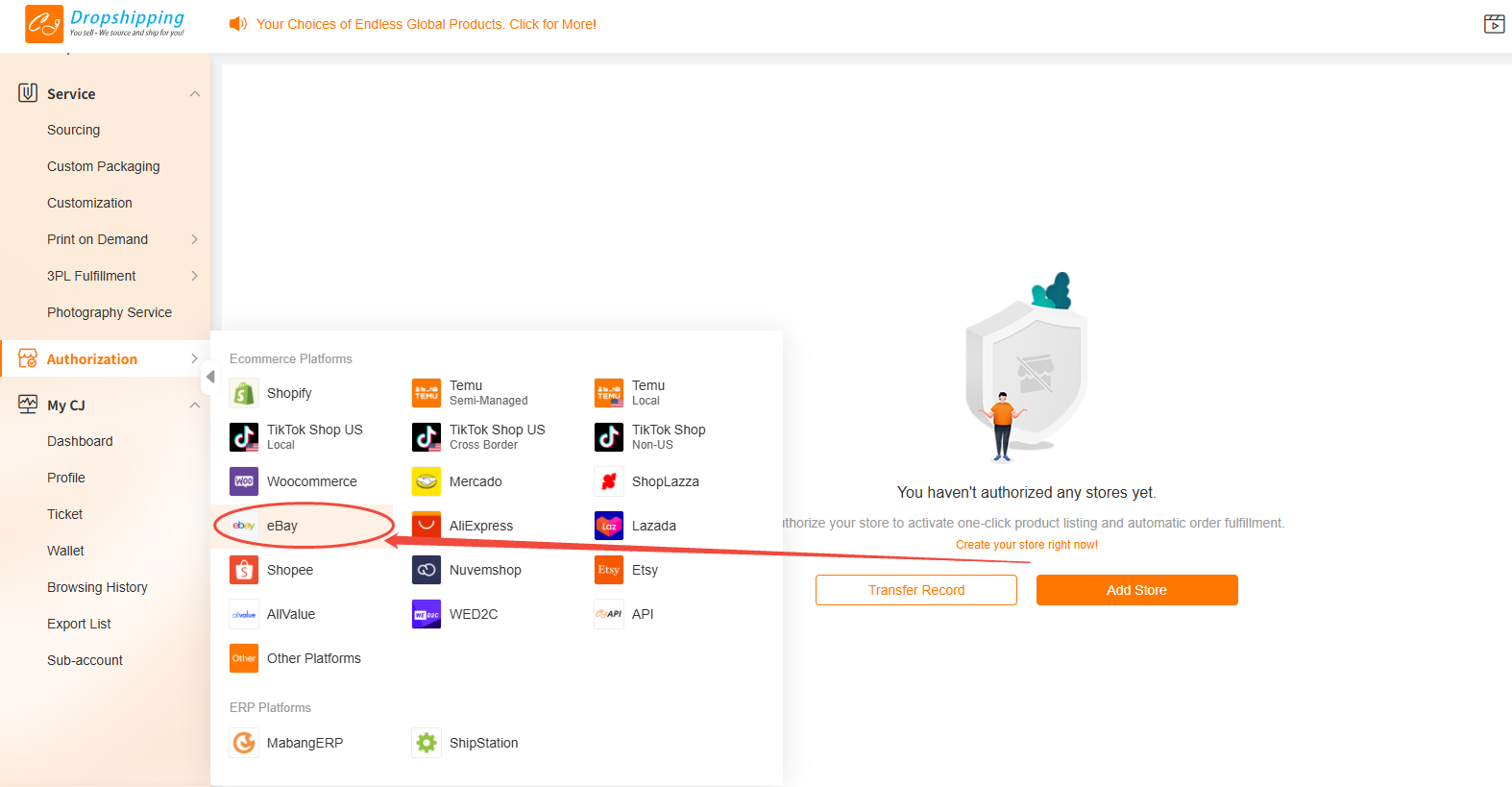
Once your store gains traction, manual order processing can slow you down and cause mistakes. Automation keeps your workflow fast and accurate.
-
CJdropshipping: Fully integrates with eBay for automatic order syncing, real-time inventory updates, and tracking uploads. With global warehouses, it can shorten delivery times for key markets.
-
AutoDS: Manages product imports, price monitoring, and auto-ordering, reducing the need for constant manual checks.
Pro Tip: Set up low-stock alerts to avoid overselling — nothing kills a feedback score faster than cancelled orders.
4. Pricing & Repricing Tools: Stay Competitive 24/7
On eBay, price competitiveness is critical, but changing prices manually is a losing game.
-
RepricerExpress: Adjusts your prices automatically based on competitor listings and your profit margin rules.
-
StreetPricer: Specifically built for eBay sellers, it tracks competitors in real time and changes your pricing dynamically to maintain a winning edge.
Pro Tip: Avoid the race to the bottom — use repricers to optimize for both competitiveness and profitability.
5. Customer Service Management: Protect Your Seller Reputation
eBay buyers expect quick, clear responses — and a high feedback score can be the deciding factor in a purchase.
-
Replyco: Centralizes messages from eBay and other platforms into one inbox for faster replies.
-
Zendesk / Freshdesk: For larger-scale operations, these tools help assign tickets, create response templates, and track resolution times.
Pro Tip: Use pre-written responses for common questions, but personalize them enough to feel human — automation should enhance customer service, not make it robotic.
6. Analytics & Profit Tracking: Know Your Numbers
Scaling without knowing your margins is dangerous.
-
Sellerboard: Breaks down profit and loss per product, factoring in all costs, including eBay fees, PayPal fees, and shipping.
-
SimplyCost: Integrates with your store to track profitability in real time.
Pro Tip: Review analytics weekly — small leaks in profitability can turn into major losses if ignored for months.
Building a Long-Term eBay Dropshipping Store
Succeeding on eBay in 2025 is no longer about chasing quick wins or relying on one viral product. The sellers who stand out are those who build stores with staying power — brands customers recognize, trust, and return to. Here's how to future-proof your eBay dropshipping business.
1. Develop a Cohesive Brand Identity
Even if you're selling a variety of items, your store should feel consistent. Use a professional logo, a memorable store name, and a clear theme for your product range. High-quality images, uniform listing layouts, and consistent copywriting all help position you as more than "just another eBay seller."
2. Specialize in Authority and Loyalty
While it's tempting to sell anything that moves, narrowing your niche can make you a go-to seller in that category. Whether it's home fitness gear, outdoor tools, or phone accessories, specialization helps you:
-
Build targeted marketing campaigns.
-
Negotiate better pricing with suppliers.
-
Gain repeat buyers who know you're the expert in that niche.
3. Create a Repeat Customer Strategy
eBay makes it easy to run promotions for past buyers. Set up:
-
Discount coupons for repeat purchases.
-
Bundled offers to increase average order value.
-
Seasonal re-engagement campaigns for holiday and trend-driven items.
Your long-term profit often comes from customer lifetime value, not the first sale.
4. Leverage Data to Drive Inventory Decisions
Your eBay Seller Hub offers valuable insights on what's selling, what's stagnating, and which listings are converting best. Pair this with tools like Terapeak to identify emerging trends and product gaps. This data-driven approach prevents overstock and ensures you're always aligned with demand.
5. Maintain Supplier Relationships for Stability
Strong relationships with reliable suppliers mean you can:
-
Secure better pricing.
-
Get priority on stock during peak demand.
-
Arrange special packaging or branding requests.
Suppliers like CJdropshipping can streamline this process with their product sourcing, global warehouses, and automated eBay integration — all of which keep operations smooth while you focus on growth.
6. Diversify Without Diluting Your Brand
Once your core store is performing well, consider introducing complementary products or expanding into related niches. This spreads risk while keeping your offerings relevant to your existing audience.
7. Prioritize Service Quality as You Scale
As you grow, it's easy to lose sight of the service level that got you initial traction. Keep response times fast, returns simple, and communication clear. On eBay, a few bad reviews can drag down your ranking, so protect your reputation like an asset — because it is.
Building a lasting eBay dropshipping store isn't about chasing every flashy trend—it's about laying a foundation that keeps customers coming back year after year. That means choosing a mix of reliable best-sellers alongside a few well-researched new products, working with suppliers you trust, and making customer service a genuine priority.
As your store grows, look for ways to sharpen your edge: negotiate faster shipping with your suppliers, invest in better automation to cut down on manual work, and put real effort into creating listings that feel unique, not copy-pasted. Over time, these small improvements build momentum. Your feedback score climbs, your search visibility improves, and before you know it, your store has a reputation that attracts loyal buyers without relying solely on the next "hot" item.
In a marketplace as competitive as eBay, that's the kind of steady, dependable growth that turns a side hustle into a business you can count on.
